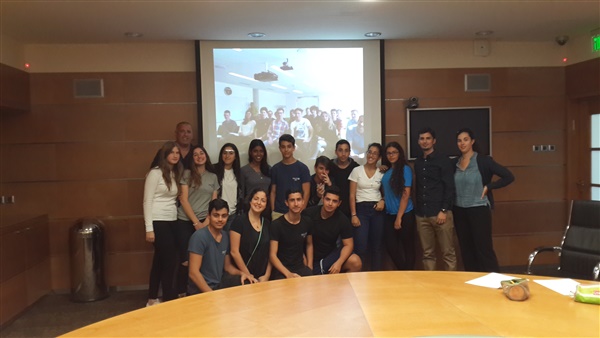Forty teenagers will be exposed to the cutting edge methods of earth observation in real time in a very special way through a joint project of the DLR_School_Lab Oberpfaffenhofen of the German Aerospace Center (DLR) and the "Earth and Planetary Image Facility" (EPIF) at BGU. Using special cameras, the young scientists will remotely explore the unique environmental conditions – in particular the vegetation – of their partner region. This notable mission was launched on Monday April 4th with a video conference between both student groups.
Over the coming two months, both groups will take several measurements with modern optical remote sensing systems in their home region with a special focus on flora. The team will then process their data and hand it over to their foreign partners for evaluation. Provided with the data of the other group, the teenagers will have to analyze and figure out what can be observed in the images using their acquired expertise. Alongside exciting insights about their respective environments and living conditions, the young scientists will have daily access to live satellite sensors and remote sensing through the DLR_School_Lab in Germany and the Earth and Planetary Image Facility in Israel.
During the kick-off event, both student groups met virtually for the first time and had the chance to exchange information about their countries through a joint video conference at the DLR in Oberpfaffenhofen and at BGU in Beer-Sheva. Both groups quickly recognized that their respective geographical conditions could not be more different: the opulent vegetation of the lake region in Bavaria met the bare beauty of the Israeli Negev desert. The pupils of the Kurt-Huber-Gymnasium in Gräfelfing already have their first hints. “Desert” does not necessarily mean an absence of vegetation. But what this will look like on the remote sensing data, the twenty young scientists from Gräfelfing will learn later on. Likewise, their counterparts from the Mekif Ramot high school in Beer-Sheva will learn how to analyze a totally different ecosystem over the next two months.
Both classes will have until mid-May to take pictures of their native countries and prepare for the exchange. Then things will get serious as they receive the data from the partner country. There will be another video conference at the beginning of June where the teens will present their results – and will learn if they came to the correct conclusions.
"This project is another example of one of the pleasant spin-offs of space research: international cooperation across all national boundaries driven by scientific curiosity. To quote the German ESA-astronaut Alexander Gerst: 'The earth has no boundaries,'" says DLR_School_Lab project manager Tobias Schüttler.
"This is a unique opportunity for these teenagers to see what real international scientific cooperation looks like. We are thrilled to be able to offer such opportunities to Beer-Sheva high school pupils with such a significant partner as the DLR," says Dr. Shimrit Maman, director of the EPIF.
ABOUT DLR and DLR_School_Lab
The German Aerospace Center DLR is Germany’s national research center for aeronautics and space. Its extensive research and development work in aeronautics, space, energy, transport, and security is integrated into national and international cooperative ventures. Approximately 8,000 people work for DLR at 16 locations in Germany. In Oberpfaffenhofen near Munich (Bavaria), DLR employs about 1,800 people, making it one of Germany’s largest research locations. The main activities of the 5 institutes in Oberpfaffenhofen are devoted to space missions, climate research, development of Earth observation systems and technologies, the European space-based navigation system Galileo, and research in robotics. These activities are complemented by two space operation centers, research flight operations, and the German Remote Sensing Data Center.
The DLR_School_Lab Oberpfaffenhofen is one of twelve DLR_School_Labs in Germany, where students can come to know about DLR’s research topics. Therefore it provides 13 fascinating high-tech experiments and is visited by over 3,000 students per year. Altogether the DLR_School_Labs reach more than 37,000 students every year and thus make an important contribution to attract young people to natural sciences.
ABOUT EPIF
The Earth and Planetary Image Facility is a multi-disciplinary laboratory located in the Department of Geography and Environmental Development at Ben-Gurion University of the Negev. Our research focuses on the use of remote sensing for a variety of applications and on advancing the development of currently available remote sensing methods. The students in the laboratory come from a variety of academic backgrounds, including geography, electro-optics, geology, electrical engineering, bio-medical engineering, computer sciences, and agriculture.
The laboratory is affiliated with NASA’s Regional Planetary Image Facilities program and hosts an active archive of maps and remotely sensed images from the Solar System.

